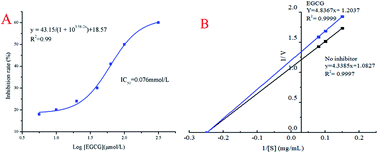Advancing insights on the anti-obesity biochemical mechanism of (−)-epigallocatechin gallate (EGCG) by inhibiting α-amylase activity†
Abstract
To fully understand the biochemical mechanisms of (−)-epigallocatechin gallate (EGCG) against obesity disease, the molecular inhibitory effects of EGCG on human salivary α-amylase are comprehensively investigated in vitro based on α-amylase activity, reaction kinetics, thermodynamics, morphology, conformation as well as histological analyses and physiological indexes of obesity mice in vivo after 30-day EGCG oral administration. Results show that the inhibition effect of EGCG against α-amylase activity is obvious with a half inhibitory concentration (IC50) value of 0.076 mmol L−1, and reaction kinetics reveal that EGCG decreases Vmax while Km remains unchanged, which indicates that EGCG inhibits α-amylase in a noncompetitive fashion with regard to substrate concentration. Thermodynamics by the differential scanning calorimetry (DSC) elucidates that α-amylase presents high thermostability in the presence of EGCG. From the data of circular dichroism (CD) and fluorescence spectroscopic (FS) analyses, it is found that EGCG can change the α-amylase secondary structure and expose Trp residues of the unfolding protein structure in the microenvironment, as well as dynamically quench α-amylase fluorescence through the formation of soluble EGCG-α-amylase aggregation complexes, which are characterized by atomic force microscopy (AFM) and Bio-Rad solubility measurements. Histological observations of adipose and hepatic tissues in vivo confirm that the beneficial effects of EGCG administration are a reduction in lipid accumulation, and lowing of the glucose level in the serum of obesity mice. Our findings demonstrate that the anti-obesity biochemical effects of EGCG can be explained by the salivary α-amylase inhibition activity, which attenuates the development of obesity disease.


 Please wait while we load your content...
Please wait while we load your content...